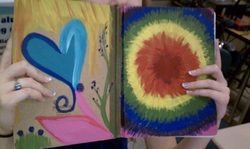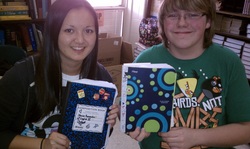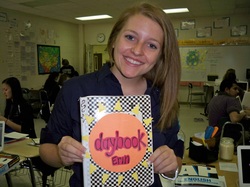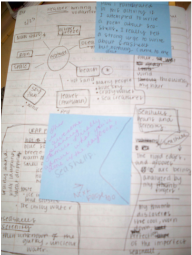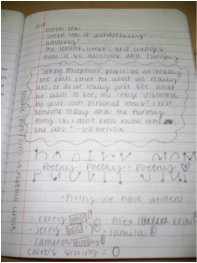A Day in the Classroom
Given below are just a few examples of what we do every day in both English 2 and AP Language and Composition. "The Daybook" section discusses the writer's notebook we use as a crucial tool in our class instruction. "A Quick Look at a Typical Class Period" includes a link to a video of some clips from one particular day in class, as well as some additional information. Finally, the "Student Work" section provides examples of student artifacts and various class projects. Please feel free to check it out!
The Daybook
One of the most important tools I used in the classroom is the daybook. My concept of the daybook is derived from the writer's notebook outlined in the book, Thinking Out Loud on Paper: The Student Daybook as a Tool to Foster Learning by Brannon, et. al. This book describes the daybook as a "kitchen junk drawer," a place to store everything. We followed this definition in all three of my classes, continually writing and reflecting in the same place. In this way, our daybooks became something that couldn't be left at home, that had all of our thoughts and ideas about class and the world around us.
Daybooks are composition notebooks, that the students did a great job of personalizing and making their own. Using a composition notebook is important because the pages are little bit more difficult to rip out. This teaches students the importance of the writing process and how to go back to their writing to make connections and write new pieces. We all wrote in our daybooks multiple times a class period, helping students practice writing, and also providing more fuel for class discussion.
I assessed the daybook through periodical daybook checks, in which students chose entries for me to read and also reflected on them. In this way, the daybook still belonged to the student, and they could feel comfortable writing in whatever way made sense to them. This again encourages the writing process and helps students become even more comfortable with themselves as writers. Many students reflected to me at the end of my student teaching, that while the daybook had taken some getting used to, they had definitely seen improvement in their writing. I can certainly agree with that statement.
Given below are few examples from one student's daybook. She took the idea behind the daybook and not only ran with it, but also made it her own.
Daybooks are composition notebooks, that the students did a great job of personalizing and making their own. Using a composition notebook is important because the pages are little bit more difficult to rip out. This teaches students the importance of the writing process and how to go back to their writing to make connections and write new pieces. We all wrote in our daybooks multiple times a class period, helping students practice writing, and also providing more fuel for class discussion.
I assessed the daybook through periodical daybook checks, in which students chose entries for me to read and also reflected on them. In this way, the daybook still belonged to the student, and they could feel comfortable writing in whatever way made sense to them. This again encourages the writing process and helps students become even more comfortable with themselves as writers. Many students reflected to me at the end of my student teaching, that while the daybook had taken some getting used to, they had definitely seen improvement in their writing. I can certainly agree with that statement.
Given below are few examples from one student's daybook. She took the idea behind the daybook and not only ran with it, but also made it her own.
A Quick Look at a Typical Class Period
While each class period certainly isn't the same everyday, to see a typical day in my classroom, please follow the video link given below. This link houses a fifteen minute video clip of a lesson, an explanation of that video, and some additional classroom photos. Please feel free to check it out!
http://studentteachingvideo.shutterfly.com/
http://studentteachingvideo.shutterfly.com/
Student Work
Throughout each unit, the students worked on a number of different projects. These assignments took place both inside and outside of class, as well as in groups, partners, and on a individual basis. Examples of projects include pieces of writing, presentations, visual projects, and other methods to interpret and discuss literature. Detailed below are just of few of those assignments and actual images from students' work. This is by far, one of the best parts of my student teaching portfolio, and I had a difficult time choosing examples from such awesome student work!
Personal Study Guide
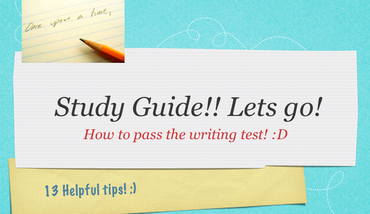
This student artifact from one of the English 2 classes is an example of a personal study guide we developed to prepare for the North Carolina Writing Assessment at Grade 10. This activity was part of a webquest, which asked students to answer research questions based off of the DPI website on the writing assessment, in order to develop a "helpful hints" study guide that was unique to them. Since not all students write the same, not all students need to study the same material. By making this an individual activity, students were able to really prepare in a way that made sense to them, beyond what we had already discussed in class.
Cinderella Presentations
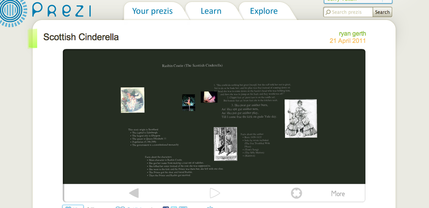
In our unit in English 2 on fairy tales from around the world, we took to classic "Cinderella" story and looked how cultures from around the world perceive this tale. Students worked in partners to explore and research a specific Cinderella story from around the world, and then use that information to build a presentation. For their presentation, students were asked to use the online program "prezi," which allows a unique form of zooming presentation more compatible with our literature study, and that also familiarizes them with more online resources. This student artifact looks at the Scottish Cinderella story, "Rashin Coatie."
Original Fairy Tales
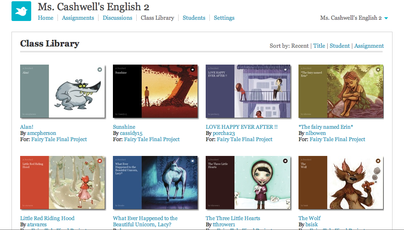
For part of our final project in the English 2 fairy tales unit, students were asked to take the fairy tale conventions we discussed in class and use them in their own writing. Students used the online program "storybird," which provides art and a story template. This activity also connected with the second part of our final unit assessment, which was a reflective letter in which students discussed the appeal of fairy tales over time, using class activities to support their conclusions. This screen shot is a picture of our class library, where we were able to house all of our stories from class. The covers of a few of the students' fairy tales are featured here.
Body Biographies
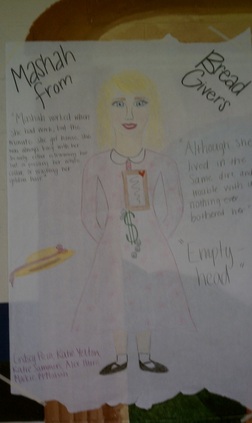
This in-class assignment was completed in the AP Language and Composition literature circles. Each group of four or five students read the same book, each centered around our unit theme, various ideas of American identity. To encourage students to think critically about their novel and also for use as a discussion tool, students were asked to make "body biographies." The ideas behind this project is for students to outline a key character from the text and then visually represent their personality, desires, what's important to them, and any other key ideas. This student artifact featured in the image above is an example of a body biography from the book Bread Givers. The symbols along the spine represents this character's "backbone," or what she values.
Book Talks
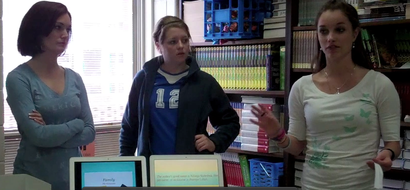
At the conclusion of our literature circles in the American Identity unit for AP Language and Composition, each group presented their book through a "book talk." This group presentation asked students to not just summarize the plot of their novel, but to think critically of the text, presenting key symbols and relating the content to our unit theme. Presentations took place in one class period and were conducted in a "round-table" fashion. In this way, students were able to experience the ideas behind multiple books besides their own, in order to relate to a central theme. The students did an outstanding job on these presentations, and the image above is a picture of some of the students as they present.
Poe Projects
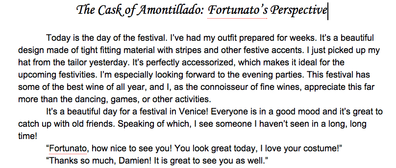
This was also an in-class group project for AP Language and Composition. As part of our unit on death and dying in American Literature, we had to take a look at the works of Edgar Allan Poe. Rather than have each student read all of his works individually, we worked to get an overview, by having students meet in "home" groups and then "reading" groups. By reading a specific story together in their reading groups and presenting those stories, they could return to their home groups later and explain their specific story. In this way, each student was able to experience more of a crucial literary figure, and the overarching ideas that we pulled from Poe's works also acted as a discussion point.
